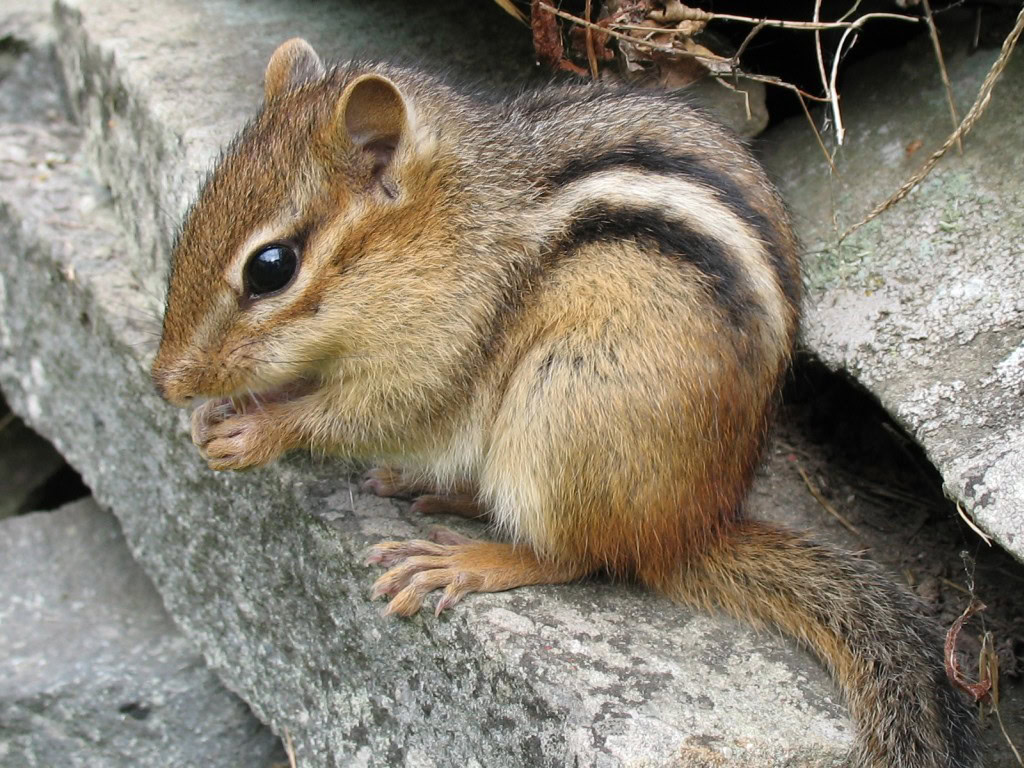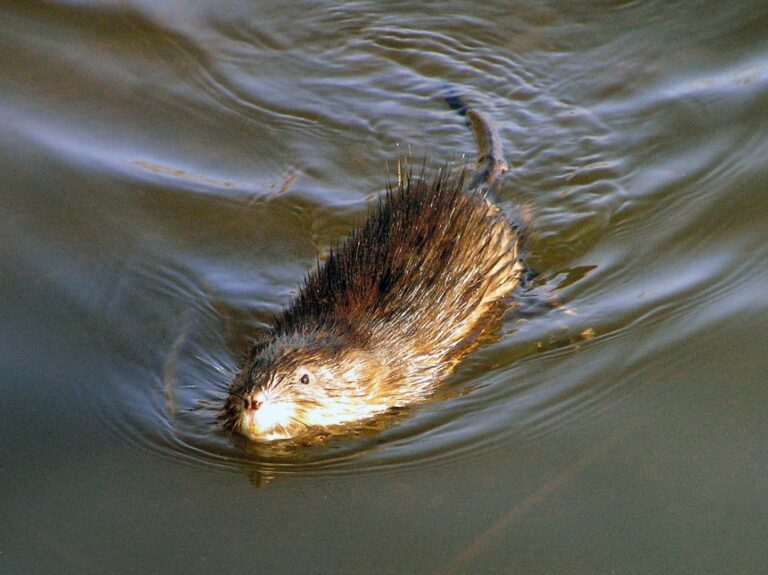Chipmunk
What is the Eastern Chipmunk?
The Eastern Chipmunk (Tamias striatus) belongs to the Sciuridae family and is distinguished by its five black stripes on a brown or grayish background, extending from its forehead to its tail. Omnivorous, these small rodents have a varied diet that includes seeds, nuts, fruits, insects, and even sometimes small vertebrates.
Although adorable, Eastern Chipmunks can cause problems by digging burrows in gardens, entering attics for hibernation, and stealing food meant for local wildlife or pets.
How to Identify the Eastern Chipmunk?
The Eastern Chipmunk, with its modest size of 20 to 30 cm in length including the tail, is easily identifiable by its striped fur and expandable cheek pouches, which it skillfully uses to carry food and materials to its burrow. This clever animal is often seen in gardens and green spaces, where it digs small entrance holes for its burrows, leaving behind clues such as piles of seeds and empty shells, as well as noticeable damage to plants and young shoots.
These signs, though subtle, can quickly accumulate, revealing the extent of their activity in a given area. In addition to foraging for food, Eastern Chipmunks are also known for their ability to create a complex network of tunnels and underground chambers, which can disrupt the soil structure and plant roots in gardens and parks.

Additional Information on the Eastern Chipmunk
Pest Type
The Eastern Chipmunk is an omnivorous mammal known for its small size, agility, and food-storing behavior, which can lead to conflicts with humans in residential areas and gardens.
Appearance
With distinctive striped fur, these creatures are recognizable not only by their facial “mask” but also by their agile body ideal for climbing and foraging.
Lifespan
Living up to three years in the wild, their rapid reproductive capacity necessitates effective management to avoid overpopulation.
Habitat
Adapted to a variety of environments, they prefer areas that offer both vegetation cover and easy access to food.
Diet
Their varied diet allows them to survive in different habitats, but also makes them vulnerable to conflicts with human activities.
Life Cycle
Annual reproduction and the ability of females to give birth to multiple offspring per litter can quickly increase their population in favorable areas.
Do I Have a Chipmunk Problem?
If your garden becomes the scene of intense digging activities, food disappearance, or if you discover burrows near your home, it is likely that Eastern Chipmunks are at work. Exterminapro’s intervention can help you control these unwanted visitors effectively.
Signs of a Chipmunk Infestation
- Burrows and Digging Holes: The presence of small entrance holes and complex tunnel systems, often hidden under vegetation or near foundations, clearly indicates chipmunk activity in your garden.
- Stored Food: Finding stores of seeds, empty shells, and other food remnants in unlikely places can signal that chipmunks are using your property to store their food.
- Plant Damage: Observing damage to young shoots, flower bulbs, or vegetables, often dug up or eaten, can be a sign of a chipmunk infestation, requiring control measures.


Risks Associated with Eastern Chipmunks
While often perceived as mere nuisances, Eastern Chipmunks have the potential to cause significant damage to gardens and outdoor spaces by stealing food meant for local wildlife or pets, and even, in rare cases, transmitting diseases. Their tendency to store large quantities of food for the winter can also lead them to enter buildings or structures in search of storage spaces, posing risks of structural damage.
To address these challenges, Exterminapro offers a range of customized solutions to control and manage Eastern Chipmunk populations, from humane trapping and exclusion methods to advice on modifying the environment to make it less attractive to these small rodents. By relying on an integrated and environmentally respectful approach, Exterminapro aims to reduce conflictual interactions between humans and Eastern Chipmunks, while preserving biodiversity and the health of local ecosystems.
What Are the Treatments to Eliminate Eastern Chipmunks?
Managing Eastern Chipmunks requires a multidimensional approach that can include trapping, exclusion, and changes in gardening practices to make them less attractive to these small rodents.
Preventing Chipmunk Infestations
- Debris Cleanup: Keeping your garden and property free of leaf piles, wood stacks, and debris can reduce hiding and nesting sites for chipmunks, limiting their presence.
- Secure Food Storage: Ensuring that all food sources, such as birdseed or pet food, are stored in airtight or tamper-proof containers can prevent attracting chipmunks searching for food.
- Physical Barriers: Installing wire mesh or barriers around gardens, fruit trees, or bulbs can physically prevent chipmunks from accessing these food sources or using them for nesting.
Types of Treatments to Counter Eastern Chipmunks
- Selective Trapping: Using non-lethal traps, such as cage or snap traps, allows for humane and effective capture of chipmunks, facilitating their relocation to more suitable habitats away from residential areas. This method respects animal welfare while protecting your property.
- Natural Repellents: Employing natural repellents, including solutions based on cayenne pepper, essential oils, or vinegar, can serve to keep chipmunks away without harming them. These substances, applied around gardens or feeding areas, alter chipmunk behavior by making treated areas less attractive.
- Strategic Landscaping: Selecting plants less appetizing to chipmunks, such as certain flowers or shrubs, and organizing your garden to discourage their presence can greatly reduce their interest in your green spaces. Adding stones or mulch can also limit areas suitable for their digging.
How to Permanently Eradicate Chipmunks?
For a long-term solution, Exterminapro combines wildlife expertise and respectful approaches to reduce Eastern Chipmunk populations and prevent their return. Contact us for a consultation and discover how we can restore peace to your outdoor space.
Intervention Process
How Much Does It Cost?
Get a Free Estimate
The cost of exterminating Eastern Chipmunks varies depending on the extent of the infestation and the treatment methods used. Exterminapro offers free evaluations to determine the best strategy for your specific case. Contact us today to secure your property against these mischievous intruders.







